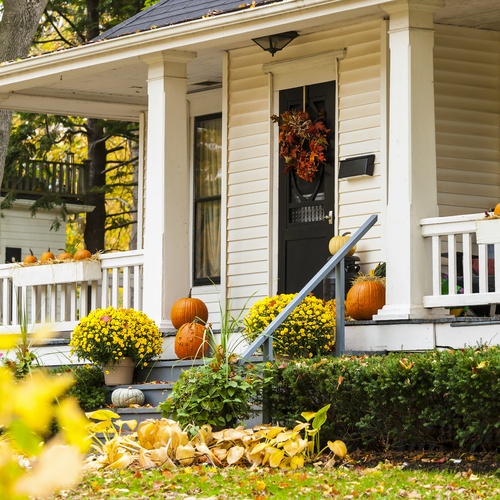Boosting Your Fall Curb Appeal

Fall is here, and there’s no better time to make your home’s exterior look amazing! Boosting your curb appeal is an easy way to make your home more attractive to potential buyers. By sprucing up your home’s exterior, it makes a great first impression and entices buyers to want to see more. Here are some simple ideas to get you started.
Clean it up
First things first – it’s time to clean up your yard. Trim trees and bushes and clean up all the fallen leaves. Remove dead or dying plants from your garden beds. Make sure your driveway and all walkways are free of debris. If needed, use a power-washer to clean sidewalks, driveways, and porches. If there are cracks or holes in your driveway that needs new paving, you may contact a commercial paving contractor to give it a makeover.
You may also consider resin bound surfacing as it is very low maintenance with just an annual power wash. And don’t forget the gutters! Potential buyers will be looking at everything, including the roof and gutters. You may want to hire a roofing contractor to inspect your roofing system and do the necessary repairs. If you do nothing else to your home’s exterior, then make sure it is at least cleaned up.
Add colorful flowers
Nothing says “fall” quite like a big pot of mums, and right now they can be purchased at just about every home improvement store or garden center. You don’t need to invest much to make a big impact. A few potted mums in seasonal decorative pots placed around your garden or on your front porch will make your home look cozy and inviting. Just be sure to keep them watered and deadhead any spent flowers to keep them looking fresh.
Paint
There is nothing more refreshing than a new coat of paint. Consider painting your front door to add a pop of color to your home’s exterior. Painting your front door is quick and inexpensive, and can really add to your curb appeal. While you’re at it, you might also paint your mailbox or invest in a new one. If your home’s trim is looking a little shabby, now is also the time to refresh it with a new coat of paint. A weekend’s worth of work can really pay off in the long run.
Add seasonal decorations
Adding some seasonal decorations to your front porch is a great way to add fall curb appeal. Consider placing a few pumpkins or gourds around your entryway, and add a colorful wreath to your front door. Switch out your welcome mat for something seasonal. Just be mindful of not going overboard. Less is more when using seasonal decorations. You should also avoid using Halloween decorations that may turn some buyers off. When in doubt, leave it out.
Invest in good lighting
Fall means shorter and even darker days. When showing your home, you want there to be as much light as possible – even on the outside. This is especially true if you’re showing your house after it gets dark. Make sure all outdoor lighting is working properly and don’t be afraid to turn those lights on. Consider investing in a new porch light, and add lighting to any area of your yard that may be too dark. Motion-sensing lights not only help to keep your yard illuminated, but they are also a great crime deterrent.
Compliments of Virtual Results




 Colder weather is just around the corner. Are your windows ready to keep out the chill? Whether you’ve just moved into a new home or you’ve been in your current home for years, it’s a good idea to prepare your windows for dropping temperatures. We also had
Colder weather is just around the corner. Are your windows ready to keep out the chill? Whether you’ve just moved into a new home or you’ve been in your current home for years, it’s a good idea to prepare your windows for dropping temperatures. We also had  You’ve made a substantial investment in your luxury home. When it’s time to sell, you want the process to run smoothly. Selling a luxury home presents it own particular challenges, and it’s important to understand them before putting your home on the market. If you’re getting ready to sell your
You’ve made a substantial investment in your luxury home. When it’s time to sell, you want the process to run smoothly. Selling a luxury home presents it own particular challenges, and it’s important to understand them before putting your home on the market. If you’re getting ready to sell your  It’s official – fall is here! Not only does that mean it’s time for pumpkin spice lattes and cozy sweaters, but it’s also time for fall home maintenance. With the weather changing from hot to cool, it’s time to prep your home for the fall and winter seasons. Taking care of routine maintenance helps ensure you don’t face more serious problems down the line. Here’s the rundown of those tasks you should complete in the coming weeks.
It’s official – fall is here! Not only does that mean it’s time for pumpkin spice lattes and cozy sweaters, but it’s also time for fall home maintenance. With the weather changing from hot to cool, it’s time to prep your home for the fall and winter seasons. Taking care of routine maintenance helps ensure you don’t face more serious problems down the line. Here’s the rundown of those tasks you should complete in the coming weeks. As a seller, you spend quite a bit of time preparing your home for the market. From decluttering and depersonalizing to making repairs and upgrades, you have plenty to do. Decluttering your house can seem like a challenging task, but you will organize your home without hassles if you do what is necessary. Since we live hectic lifestyles, clutter can build up fast, you may see these
As a seller, you spend quite a bit of time preparing your home for the market. From decluttering and depersonalizing to making repairs and upgrades, you have plenty to do. Decluttering your house can seem like a challenging task, but you will organize your home without hassles if you do what is necessary. Since we live hectic lifestyles, clutter can build up fast, you may see these 
 Would you be surprised to learn that
Would you be surprised to learn that  If you’re a homebuyer with kids, then you know there are certain basic requirements the home needs to provide. You want it to be safe, have a place to play, and be located in a good school district. But are there other characteristics you should be looking for when searching for a home, other than the basics? Here’s a look at what you should consider when buying a kid-friendly home.
If you’re a homebuyer with kids, then you know there are certain basic requirements the home needs to provide. You want it to be safe, have a place to play, and be located in a good school district. But are there other characteristics you should be looking for when searching for a home, other than the basics? Here’s a look at what you should consider when buying a kid-friendly home.
 When you’re preparing to put your home on the market, you want to make it as attractive as possible to potential buyers. But what you do – or don’t do – can either get buyers excited or turn them off. Knowing what buyers don’t want is crucial when it’s time to sell your home. Here’s a list of the most common homebuyer turnoffs that you need to avoid.
When you’re preparing to put your home on the market, you want to make it as attractive as possible to potential buyers. But what you do – or don’t do – can either get buyers excited or turn them off. Knowing what buyers don’t want is crucial when it’s time to sell your home. Here’s a list of the most common homebuyer turnoffs that you need to avoid.

 Catch Our Feed
Catch Our Feed Subscribe via Email
Subscribe via Email Follow Our Tweets
Follow Our Tweets Friend Us On Facebook
Friend Us On Facebook Watch Us On Youtube
Watch Us On Youtube